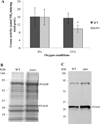Role of Helicobacter pylori methionine sulfoxide reductase in urease maturation
- PMID: 23181726
- PMCID: PMC3935233
- DOI: 10.1042/BJ20121434
Role of Helicobacter pylori methionine sulfoxide reductase in urease maturation
Abstract
The persistence of the gastric pathogen Helicobacter pylori is due in part to urease and Msr (methionine sulfoxide reductase). Upon exposure to relatively mild (21% partial pressure of O2) oxidative stress, a Δmsr mutant showed both decreased urease specific activity in cell-free extracts and decreased nickel associated with the partially purified urease fraction as compared with the parent strain, yet urease apoprotein levels were the same for the Δmsr and wild-type extracts. Urease activity of the Δmsr mutant was not significantly different from the wild-type upon non-stress microaerobic incubation of strains. Urease maturation occurs through nickel mobilization via a suite of known accessory proteins, one being the GTPase UreG. Treatment of UreG with H2O2 resulted in oxidation of MS-identified methionine residues and loss of up to 70% of its GTPase activity. Incubation of pure H2O2-treated UreG with Msr led to reductive repair of nine methionine residues and recovery of up to full enzyme activity. Binding of Msr to both oxidized and non-oxidized UreG was observed by cross-linking. Therefore we conclude Msr aids the survival of H. pylori in part by ensuring continual UreG-mediated urease maturation under stress conditions.
Figures






References
-
- Marshall BJ, Warren JR. Unidentified curved bacilli in the stomach of patients with gastritis and peptic ulceration. Lancet. 1984;1:1311–1315. - PubMed
-
- Bagchi D, Bhattacharya G, Stohs SJ. Production of reactive oxygen species by gastric cells in association with Helicobacter pylori. Free Radical Res. 1996;24:439–450. - PubMed
-
- Ramarao N, Gray-Owen SD, Meyer TF. Helicobacter pylori induces but survives the extracellular release of oxygen radicals from professional phagocytes using its catalase activity. Mol. Microbiol. 2000;38:103–113. - PubMed
Publication types
MeSH terms
Substances
Grants and funding
LinkOut - more resources
Full Text Sources
Other Literature Sources

